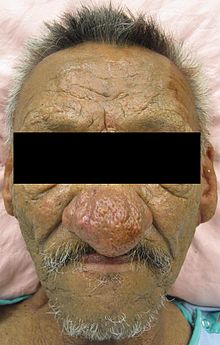| Revision as of 00:25, 27 May 2016 editTom.Reding (talk | contribs)Autopatrolled, Extended confirmed users, Page movers, Template editors3,930,870 editsm CS1 maintenance: vauthors/veditors or enumerate multiple authors/editors; WP:GenFixes on, using AWB← Previous edit | Revision as of 03:28, 16 July 2016 edit undoIQAndreas (talk | contribs)46 editsm →Pathophysiology: Add links to 'hypertrophy' and 'sebaceous gland'[REDACTED] articlesNext edit → | ||
| Line 24: | Line 24: | ||
| ==Pathophysiology== | ==Pathophysiology== | ||
| Rhinophyma is a slowly progressive condition due to hypertrophy of the sebaceous |
Rhinophyma is a slowly progressive condition due to ] of the ]s of the tip of the nose often seen in cases of long-standing ]; it is not a ]. It presents as a pink, lobulated mass over the nose with superficial vascular dilation; it mostly affects men past middle age. Patients seek advice because of the perceived unsightly appearance of the enlargement, or obstruction in breathing and vision. | ||
| ==Diagnosis== | ==Diagnosis== | ||
Revision as of 03:28, 16 July 2016
Medical condition| Rhinophyma | |
|---|---|
| Specialty | Dermatology |
Rhinophyma is a condition causing development of a large, bulbous, ruddy nose associated with granulomatous infiltration, commonly due to untreated rosacea.
Signs and symptoms

Rhinophyma is characterised by prominent pores and a fibrous thickening of the nose, sometimes with papules. It is associated with the common skin condition rosacea. It can carry a strong psychological impact due to its effect on one's personal appearance.
Causes
Alcoholism is mistakenly attributed as a cause of this disease. Alcohol however may cause increased flushing in those affected.
Pathophysiology
Rhinophyma is a slowly progressive condition due to hypertrophy of the sebaceous glands of the tip of the nose often seen in cases of long-standing acne rosacea; it is not a neoplasm. It presents as a pink, lobulated mass over the nose with superficial vascular dilation; it mostly affects men past middle age. Patients seek advice because of the perceived unsightly appearance of the enlargement, or obstruction in breathing and vision.
Diagnosis
Rhinophyma may be diagnosed without testing, but a skin biopsy can confirm the diagnosis.
Treatment
Treatment consists of paring down the bulk of the tissue with a sharp instrument or carbon dioxide laser and allowing the area to re-epithelialise. Sometimes, the tissue is completely excised and the raw area skin-grafted.
Etymology
The term rhinophyma is derived from the Greek rhis ('nose') and phyma ('growth').
See also
References
- Cohen AF, Tiemstra JD (2002). "Diagnosis and treatment of rosacea". J Am Board Fam Pract. 15 (3): 214–7. PMID 12038728.
- "Rosacea". Dermnetnz.org.
- "Rhinophyma". Rhinophyma. Retrieved 24 March 2011.
- ^ Fitzpatrick, James E.; Morelli, Joseph G. Dermatology Secrets Plus (5th ed.). Elsevier Health Sciences. p. 511. ISBN 9780323313551. Retrieved 10 May 2016.
- Dingra PL. Diseases of Ear, Nose and Throat (4th ed.).
External links
- MedEd at Loyola medicine/dermatology/melton/rhino1.htm
- About rhinophyma at orlhns.info
- Rhinophyma Treatment
- janjuafacialsurgery (Contributor) (2012-05-10). Rhinophyma Excision by Janjua Facial Surgery. Retrieved 2013-02-10.